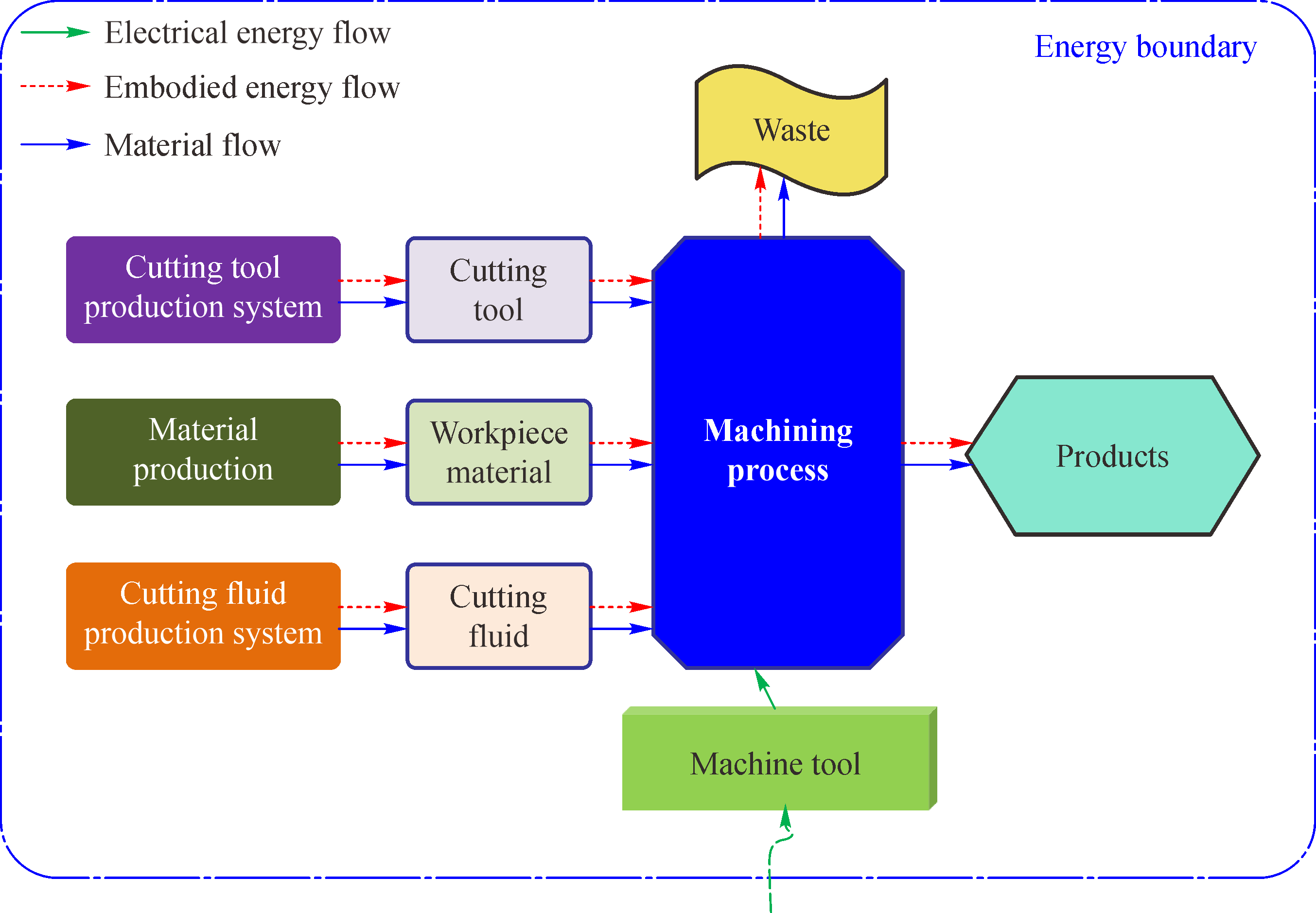| Cutting parameter optimization by using experimental design and mathematical models, such as ANN, RSM or Kriging model | Jang et al. [48] | Milling, ANN-based energy model | | N/A | PSO was used to find the optimal cutting parameters for minimizing specific cutting energy. Minimum energy consumption can be achieved with a large feed rate and cutting depth |
| Li et al. [35] | Milling, RSM-based energy model | | Machining time | A trade-off is found between SEC and machining time. Cutting width is observed to be the major factor affecting SEC, followed by cutting depth, feed rate, and cutting velocity. Minimum energy consumption can be achieved with a large cutting velocity, feed rate, cutting depth, and cutting width |
| Moreira et al. [14] | Milling, RSM-based energy model | | MRR, power load | Feed rate is found to be the most significant factor on SEC. A large feed rate is recommended for energy efficient machining |
| Nguyen [15] | Milling, Kriging-based energy model | | Surface roughness, production rate | Cutting depth is the most influential parameter on SEC. Large cutting parameters can decrease SEC |
| Cutting parameter optimization by using empirical models | Rajemi et al. [13] | Turning (EMMBMS) | | × | Optimal cutting parameters vary with energy boundaries. The optimal cutting parameters for minimum cost does not necessarily satisfy the minimum energy criterion |
| Arif et al. [16] | Turning (EMMBMS) | | × | Influence of cutting parameters on energy consumption is different in roughing pass and finishing pass |
| Li et al. [49] | Milling (EMMBMS) | | Surface roughness | Increasing feed rate but decreasing spindle speed can reduce energy consumption and improve production rate |
| Velchev et al. [50] | Milling (EMMBMS) | | × | Low energy consumption can be achieved with maximum possible values of feed rate and cutting depth |
| Wang et al. [33] | Turning (EMMBMS) | | Machining cost, surface roughness | Cutting parameter optimization is significant to energy reduction but optimization effect on surface roughness is limited. Cutting parameters are ranged in relatively reasonable ranges before optimization |
| Albertelli et al. [51] | Milling (EMMBMTC) | | × | The optimal cutting parameters for minimum energy consumption is different from that of minimum machining time. Proper selection of cutting parameters can reduce both energy consumption and the machining time |
| Ma et al. [52] | Millling (EMMBMS) | | × | Increment of cutting velocity leads to a decrement of energy consumption |
| Xiong et al. [53] | Milling (EMMBMS) | | Milling dimensional accuracy, machining time, machining cost | Multiobjective cutting parameter optimization obtained a more reasonable results even each objective is not the absolute optimal |
| Deng et al. [54] | Milling (EMMBMS) | | Machining time | Cutting specific energy consumption first decreased and then increased with the increase of cutting velocity, while it always decreased with the increase of feed rate, cutting depth and cutting width |
| He et al. [55] | Milling and turning (EMMBMTC) | | Machining time, cutting force | Different algorithms can be selected for different machining conditions and demands of specific objective problem |
| Li et al. [25] | Milling (EMMBMS) | | Machining cost | Specific energy consumption first decreases with the increase in cutting velocity and then increases. It always decreases with the increase in feed rate and cutting depth |
| Lu et al. [17] | Turning (EMMBMS) | | Machining precision | A balance is found between minimum energy consumption and maximum machining precision. MOBSA outperforms NSGA-II, MOPSO, multiobjective evolutionary algorithm based on decomposition (MOEA/D), and MOHS |
| Zhang et al. [56] | Milling (EMMBMS) | | Machining time, carbon emission | Energy consumption can be reduced with a large cutting velocity, feed rate, cutting depth, and cutting width. The balance of machining time, energy consumption, and carbon emissions should be struck |
| Zhong et al. [57] | Turning (EMMBMS) | | × | The effect of feed rate on specific energy consumption is less than that of cutting velocity and cutting depth. A large feed rate can be used in energy efficient machining process |
| Zhang et al. [58] | Turning (EMMBMS) | | Noise emission, machining cost | A large feed rate and cutting depth minimize the energy consumption of the machining process. The influence of cutting speed on energy is insignificant. A conflict is found between minimizing energy consumption and noise emission |
| Bagaber and Yusoff [59] | Turning (EMMBMS) | | Machining cost, surface roughness | Minimum energy consumption can be achieved with the highest value of feed rate and lowest value of cutting depth. Feed rate is the most significant factor affecting energy consumption |
| Hu et al. [60] | Turning (EMMBMS) | | × | Simulated annealing (SA) outperforms expectation–maximization (EM) because it requires less computation time with minimal sacrifice in solution quality compared with EM |
| Li et al. [61] | Milling (EMMBMS) | | Machining time | Cutting depth and width are the most influential factors for specific energy consumption. A trade-off is found between specific energy consumption and machining time |
| Wang et al. [62] | Milling (EMMBMS) | | × | The range of cutting parameters increases with cutting tool diameter. Accordingly, a large MRR can be used to reduce energy consumption |
| Chen et al. [32] | Milling (EMMBMS) | | Machining time | Multiobjective optimization strikes a balance between minimum energy consumption and minimum machining time |










